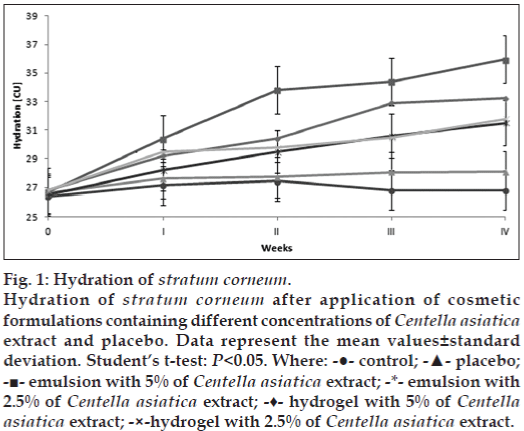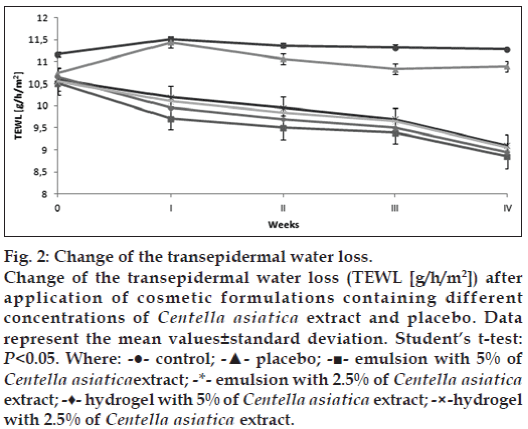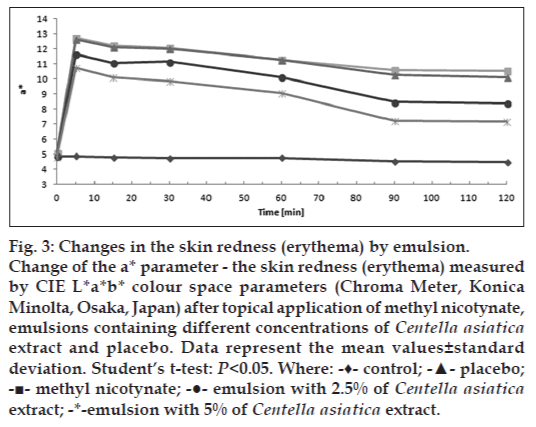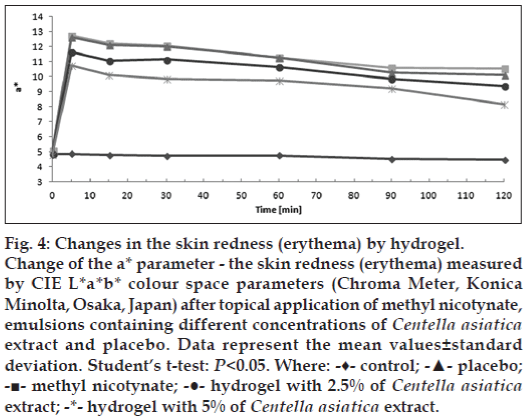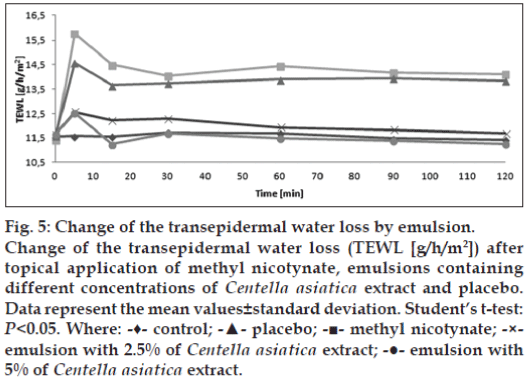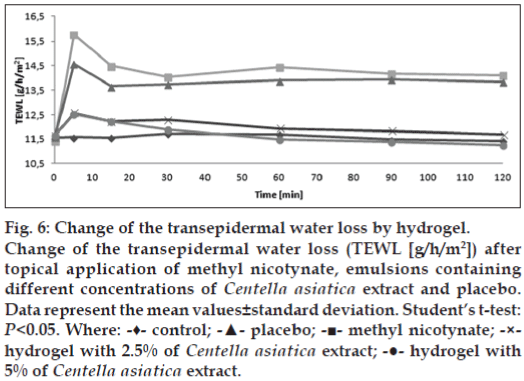- Corresponding Author:
- A. Ratz-łyko
Department of Cosmetic Chemistry, Faculty of Cosmetology, Academy of Cosmetics and Health Care, 00-252 Warsaw, Poland
E-mail: anna.ratz-lyko@wszkipz.pl
| Date of Submission | 11 December 2014 |
| Date of Revision | 17 November 2015 |
| Date of Acceptance | 05 February 2016 |
| Indian J Pharm Sci 2016;78(1):27-33 |
This is an open access article distributed under the terms of the Creative Commons Attribution-NonCommercial-ShareAlike 3.0 License, which allows others to remix, tweak, and build upon the work non-commercially, as long as the author is credited and the new creations are licensed under the identical terms.
Abstract
Centella asiaticaextract is a rich source of natural bioactive substances, triterpenoid saponins, flavonoids, phenolic acids, triterpenic steroids, amino acids and sugars. Thus, many scavenging free radicals, exhibit antiinflammatory activity and affect on the stratum corneum hydration and epidermal barrier function. The aim of the present study was to evaluate the in vivo moisturizing and antiinflammatory properties of cosmetic formulations (oil-in-water emulsion cream and hydrogel) containing different concentrations of Centella asiaticaextract. The study was conducted over four weeks on a group of 25 volunteers after twice a day application of cosmetic formulations with Centella asiaticaextract (2.5 and 5%, w/w) on their forearms. The measurement of basic skin parameters (stratum corneum hydration and epidermal barrier function) was performed once a week. The in vivo antiinflammatory activity based on the methyl nicotinate model of microinflammation in human skin was evaluated after four weeks application of tested formulations. In vivo tests formulations containing 5% of Centella asiaticaextract showed the best efficacy in improving skin moisture by increase of skin surface hydration state and decrease in transepidermal water loss as well as exhibited antiinflammatory properties based on the methyl nicotinate model of microinflammation in human skin. Comparative tests conducted by corneometer, tewameter and chromameter showed that cosmetic formulations containing Centella asiaticaextract have the moisturizing and antiinflammatory properties.
Keywords
Centella asiatica, stratum corneum hydration, epidermal barrier function, antiinflammatory properties
Centella asiatica (Linn.) Urban (also known by common names as: Gotu kola, Indian pennywort (ang.), Hydrocotyle asiatique (fr.) or Indischer Wassernabel (ger.)) is a species belonging to the Apiaceae family (formerly Umbelliferae), genus Centella (Linn.). Centella asiatica species is divided into three varieties, Centella asiatica var. typica, Centella asiatica var. abyssinica, Centella asiatica var. floridana, which growing in different regions, having different chemical composition and different morphology of leaves [1-4]. Centella asiatica is mainly found in India, Pakistan, Sri Lanka, Madagascar, South Africa and Eastern Europe [5]. The most important constituents isolated from C. asiatica are primarily ursane- and oleanane-type pentacyclic triterpenoid saponins (up to 8%), also known as centelloids [6]. These terpenoids include asiaticoside, centelloside, madecassoside, moside, thankuniside, sceffoleoside, centellose, as well as triterpenic acids such as asiatic, centellic, madecassic and terminolic acids [6,7]. Among the various chemicals the most important chemicals due to their dermatological and pharmacological activity are, asiaticoside, madecasosside, asiatic acid and madecassic acid [8]. Centella asiatica also contains other components, including flavonoids (quercetin and its glycoside, rutin, kaempferol and its glycoside, catechin, naringenin, apigenin, luteolin, astragalin glycoside and free form), phenolic acids (chlorogenic acid and its isomers and derivatives), triterpenic steroids (stigmasterol, sitosterol), amino acids, sugars, vitamins and essential oils and other volatile constituents in about 0.1% [9,10]. It has been known for a long time that Centella asiatica compounds exhibit a broad spectrum of therapeutic activity. The most important are antioxidant, antiinflammatory, antimicrobial and anticarcinogenic activity. In dermatology Centella asiatica is used in treatment of small wounds, hypertrophic wounds as well as burns, psoriasis and scleroderma [8]. It was observed that Centella asiatica preparations can stimulate the fibroblast proliferation and activate the SMAD signaling pathway therefore can increase the type I collagen production as well as decrease in formation of stretch marks and inflammatory reactions. Moreover, the constituents isolated from C. asiatica can increase the microcirculation of blood in the skin and prevent excessive accumulation of fat in cells [11-14]. As for a cosmetic purpose, Centella asiatica is used as an active compound in skin care preparations because its antioxidant, antiinflammatory, anticellulite and antiaging activity. Therefore Centella asiatica extract rich in triterpenes is a valuable raw material with a broad spectrum of cosmetic action.
The aim of this study was to evaluate the cosmetic properties of Centella asiatica cream and hydrogel. The researches included the impact of Centella asiatica preparations on the skin surface hydration state, barrier function of the stratum corneum and antiinflammatory properties based on the methyl nicotinate model of microinflammation in human skin. In the present study, we used in vivo techniques (corneometer, tewameter and chromameter) to evaluate the effects of cosmetic formulations containing different concentrations of Centella asiatica extract (2.5 and 5%) on skin hydration, transepidermal water loss (TEWL) and microinflammation in human skin after a four weeks period of double daily application.
Materials and Methods
Dried extract of Centella asiatica (Herbalia® Centella) containing 10% active constituents (madecassic acid, asiatic acid, asiaticoside) were purchased from Cognis Iberia s.l. (Spain).
The dried Centella asiatica was extracted with ethanol (70%, by volume). The extraction was performed with a 10:1 solvent-raw material ratio (by volume per mass) in 150-ml flasks at a temperature of 25° for 24 h on a waterbath shaker with a frequency of 200 cycles per min (Elpin-Plus, Lubawa, Poland). The obtained extracts were filtrated through Whatman filter paper (no. 1; GE Healthcare, Maidstone, UK). The extracts were collected and used for preparation of cosmetic products.
For evaluation of cosmetic properties of Centella asiatica a simple recipes of cosmetic emulsion O/W and hydrogel were developed (Tables 1 and 2). The concentration of the Centella asiatica extract in the tested cosmetics was 2.5 and 5%. The O/W emulsion was prepared by heating separately the water and oily phases (80°), followed by homogenization for 1.5 min at 1500 rpm (Heidolph, Germany) and mixing by mechanic stirrer (IKA® RW16 Basic, Germany) to achieve a temperature of 30°. Then, the extract was added. The hydrogel was prepared by mixing carbomer with water and Centella asiatica extract. The bases (placebo) were prepared without extract. All samples were freshly prepared and had the pH values of 5.5.
| INCI name | Producer | Amount (%) Trade name | |
|---|---|---|---|
| Glyceryl stearate | Cognis | 4 | Cutina GSM |
| Ceteareth- 12 | Cognis | 1.5 | Emulgin B1 |
| Ceteareth- 20 | Cognis | 1.5 | Emulgin B2 |
| Caprylic/capric triglyceride | Cognis | 3 | Myritol |
| Octyldodecanol | Cognis | 3 | Eutanol G |
| Cetyl alcohol | Cognis | 4 | Speziol C |
| 16 Pharma | |||
| Centellaasiaticaextract | Cognis | 3 | Herbalia® |
| Centella | |||
| Phenoxyethanol, | Lotioncrafter | 0.25 | LiquaPar |
| metyloparaben, ethylparaben, | Optima | ||
| propylparaben, butylparaben | |||
| Aqua | 79.75 | Water | |
Table 1: The emulsion recipe
| INCI name | Producer Amount (%) Trade name | ||
|---|---|---|---|
| Carbomer Aqua | Noveon | 10 | Carbopol |
| Centellaasiaticaextract Cognis | 3 | Herbalia®Centella | |
| Tea | POCh | q.s. | Triethanoloamine |
| Aqua | - | 96 | Water |
INCI: International Nomenclature of Cosmetic Ingredients, q.s.: quantity sufficient
Table 2: The hydrogel recipe
The group of twenty five healthy volunteers between 18 and 55 years participated in the study after giving written consent. Study was approved by ethics committee. Standardized 48 h patch test of the prepared cosmetics was carried out. The test involves the application of the examined emulsion and hydrogel to the skin under adhesive tape, which was then left in place for 48 h. The results demonstrated that topical application of the emulsion and hydrogel with Centella asiatica extract is not associated with acute skin irritation or allergic sensitization. The clinical investigator assessed that the volunteers were in good health and had no dermatological diseases. The in vivo studies for evaluation skin surface hydration state, barrier function of the stratum corneum and antiinflammatory properties (based on the methyl nicotinate model of microinflammation in human skin) of tested preparations were performed over a period of four weeks. The first was the phase consisting of the application of the o/w emulsion and hydrogel with Centella asiatica extract and placebo onto the skin areas twice a day for four weeks. In order to minimize the errors during research the volunteers were asked not to apply any cosmetic cream in the tested area two weeks before the study was carried out and throughout the test period. Additionally, solar exposure was forbidden. The tested areas (3 cm×4 cm) were the forearms of each volunteers: The inner surface of the left forearm was for emulsions with Centella asiatica extract, the placebo (base cream) was also applied on the inner surface of the left forearm, the inner surface of the right forearm was for hydrogels with Centella asiatica extract and placebo (hydrogel base), the control areas were on the outer surface of the forearms, respectively. The cream and hydrogel were applied in an uniform layer resulted from applying of 0.1 ml of the tested products by a syringe. The measurements of the skin surface hydration state (Corneometer, Multiprobe MPA5 from Courage and Khazaka Electronics GmbH, Cologne Germany) and barrier function of the stratum corneum (MPA 5 from Courage and Khazaka Electronics GmbH, Cologne Germany) were conducted before application the cosmetics and once a week (during 4 weeks).
Additionally, after four weeks the treated and control areas were measured by tewameter (MPA 5 from Courage and Khazaka Electronics GmbH, Cologne Germany) to assess barrier function of the stratum corneum, pH-meter (Mettler-Toledo Sp. z o.o.) for determination of the skin pH after skin irritation by methyl nicotynate and chromameter (Chroma Meter, Konica Minolta, Osaka, Japan) for determination of the skin irritation after application of methyl nicotynate. Then, an aqueous solution of the methyl nicotinate (0.5%, m/v, Merck) was applied for 5 min. The measurements (by tewameter, pH-meter and chromameter) were performed at 5, 15, 30, 60, 90, and 120 min after remove of the methyl nicotinate compress, respectively. All measurements were performed in controlled conditions at a temperature of 22-25o and with an average relative humidity 50%. Prior to the measurements, the volunteers were asked to stay in the test room for at least 15 min before the measurements, so the skin could acclimatize at room conditions. All measurements were performed in triplicate.
Statistical analysis
All results were presented as a mean±standard deviation of at least three independent experiments (each performed in triplicate). Statistical analysis was performed by using Student’s t-test, ANOVA models with Fisher-Snedecor test and Tukey post hoc test. Differences were accepted as statistically significant at P<0.05.
Results and Discussion
Effect of cosmetic formulations containing Centella asiatica extract in different concentrations on the skin surface hydration state and barrier function of the stratum corneum was using corneometer and tewameter and the results of the long term study are shown in figs. 1 and 2. In the experiment there was observed a significant increase in hydration of the stratum corneum after the first week application of tested preparations with 2.5 and 5% of Centella asiatica extract. The best results were observed for cosmetic formulations with 5% of Centella asiatica extract. The comparison of emulsion with hydrogel revealed that emulsion with 5% Centella asiatica extract increase in hydration of the stratum corneum by 12%, followed by hydrogel with 5% Centella asiatica by 10% in comparison to the control area and placebo (P<0.05). The average value of hydration of the stratum corneum after four weeks application of tested emulsion and hydrogel increased significantly in compared to baseline (control area) and placebo (P<0.05). It was observed that emulsion with 5% Centella asiatica extract effect on increase in skin hydration by 25%, followed by hydrogel with 5% Centella asiatica extract by 22%. The experiment realized on the basis of the analysis of variance and statistically testing using Fisher’s-Snedecora test has found that (α=0.05) on the increase in skin hydration affected significantly the duration, extract concentration and kind of the tested formulations. The Tukey post hoc test (α=0.05) performed that the average rate of increase in skin hydration after application of moisturizing emulsion with 5% of Centella asiatica extract was significantly differ in comparison to the average value after the application of moisturizing emulsion without the extract. The growth of hydration of the stratum corneum was stable. This is the evidenced that cosmetic with Centella asiatica extract may affect significantly on the increase in hydration of the stratum corneum. That is primarily bound to the presence in the Centella asiatica triterpene saponins a hydrophilic sugar chain (glycone) mainly glucose and rhamnose that have the ability to bind water within an occlusive layer [1,15]. The increase in hydration in comparative tests conducted by corneometer was also observed by Morganti et al. [16]
Figure 1: Hydration of stratum corneum. Hydration of stratum corneum after application of cosmetic formulations containing different concentrations of Centella asiatica extract and placebo. Data represent the mean values±standard deviation. Student’s t-test: P<0.05. Where: -●- control; -▲- placebo; -■- emulsion with 5% of Centella asiatica extract; -*- emulsion with 2.5% of Centella asiatica extract; -♦- hydrogel with 5% of Centella asiatica extract; -×-hydrogel with 2.5% of Centella asiatica extract.
Figure 2: Change of the transepidermal water loss. Change of the transepidermal water loss (TEWL [g/h/m2]) after application of cosmetic formulations containing different concentrations of Centella asiatica extract and placebo. Data represent the mean values±standard deviation. Student’s t-test: P<0.05. Where: -●- control; -▲- placebo; -■- emulsion with 5% of Centella asiatica extract; -*- emulsion with 2.5% of Centella asiatica extract; -♦- hydrogel with 5% of Centella asiatica extract; -×-hydrogel with 2.5% of Centella asiatica extract.
The measurement of the epidermal barrier function was carried out on a group of 25 volounteers during four weeks period of double daily applications of the emulsion and hydrogel with Centella asiatica extract and placebo. The best results were observed for cosmetic formulations with 5% of Centella asiatica extract. The results of tewameter mesurements in the long term study are shown in fig. 2. After the first week application of tested cosmetics there was observed a significant decrease in transepidermal water loss, for emulsion with 5% of Centella asiatica extract by 8%, followed by hydrogel with 5% of Centella asiatica extract 6%, emulsion with 2.5% of Centella asiatica extract by 5%, hydrogel with 2.5% of Centella asiatica extract by 4% and placebo by 1% in comparison to the control area (P<0.05). After four weeks the average value of TEWL was differ significantly compared to baseline (control field) and placebo. The decrease in transepidermal water loss after application of emulsion and hydrogel with Centella asiatica extract in different concentrations was as followed. The emulsion and hydrogel with 5% of Centella asiatica extract showed 18 and 15%, the emulsion and hydrogel with 2.5% of Centella asiatica extract have showed 10 and 8%, and placebo showed 5% in comparison to the control area (P<0.05), respectively. The decrease in TEWL after application of the emulsions was mainly related to the presence in the Centella asiatica extract the substances which can bind water on the stratum corneum surface by forming an occlusive hydrophilic film and can improve the state of the epidermal barrier, for example sugars, saponins and polyphenols [1,9,10,15,17]. The effect of emulsion and hydrogel with Centella asiatica extract on the epidermal barrier function and hydration of the stratum corneum has not been widely studied. The present results indicate that the emulsion with Centella asiatica extract has a significant impact on the skin hydratation and epidermal barrier function, especially on the epidermal barrier tightness, which is attributed to the presence of carbohydrates and natural antioxidants such as saponins, flavonoids and phenolic compounds [1,17]. In in vivo studies the emulsion with 5% of Centella asiatica extract showed the best effect on the skin hydration and the epidermal barrier function. The effect of the emulsion with Centella asiatica extract on the skin hydration and epidermal barrier function is significant and comparable with another plants [18]. Therefore, it can be concluded that the cosmetics with Centella asiatica extract may affect on the increase in hydration of the stratum corneum and the improvement of the epidermal barrier function, and thus have potential application in moisturizing, protective and antiaging cosmetics [19].
The in vivo evaluation of antiinflammatory and antioxidant properties of cosmetic formulations containing Centella asiatica extract in different concentrations were made based on the methyl nicotinate model of microinflammation in human skin [20]. Methyl nicotinate is known to induce the release of prostaglandin D2 (PGD2) resulting in localized erythema within 30 min after topical application to human skin, the release of nitric oxide from endothelial cells keratinocytes and human dermal microvascular as well as an increase in transepidermal water loss (TEWL) and skin pH [21-23]. This method based on the illumination of the skin surface by a pulsed xenon lamp and analysis the skin color by measuring the reflectance spectrophotometer using the CIE L*a*b* colour space parameters. For the measurement of the skin redness (erythema) only the CIE a* component was observed [24].
The results of the in vivo studies showed that the emulsion and hydrogel with Centella asiatica extract have a protective effect on the skin and may reduce its sensitivity to irritants. The results of tewameter and chromameter mesurements are shown in figs. 3-6. For the all applied cosmetics with Centella asiatica extract it was observed the statistically significant (α=0.05) reduction of erythema (decrease of the a* parameter value) (figs. 3 and 4) and decrease in TEWL value (figs. 5 and 6) and skin pH value (Table 3) in comparison to the control area and the placebo. Moreover, the best results (decrease of the a* parameter value, decrease in TEWL value and decrease in skin pH value) were observed after the application of emulsion with 5% of Centella asiatica extract, followed by hydrogel with 5% of Centella asiatica extract (P<0.05). Thus, it has been hypothesized that the emulsion and hydrogel with 5% of Centella asiatica extract significantly influence on increase in the regenerative capacity of the epidermal barrier and alleviating the skin irritation (figs. 3 and 4). The results indicated that the tested cosmetic formulations demonstrate the antiinflammatory activity, which is associated with the presence of the saponins. The antiinflammatory properties of Centella asiatica extract are related to the saponins especially asiaticoside ability to inhibit of the cyclooxygenase and lipoxygenase activity and proinflammatoty cytokines inhibition as well as saponins antioxidant activity [1,8,13]. The irritation after application of methyl nicotinate is related to the activation of cyclooxygenase and prostaglandin synthesis D2, actuating in release of the endoperoxydase and free radicals in the skin. This cause a local erythema, release of the nitric oxide from endothelial keratinocyte cells and human dermal microvascular as well as increased in transepidermal water loss and skin pH value [21-24]. Therefore, the active substances contained in Centella asiatica extract, especially saponins, flavonoids and phenolic acid showing antioxidant and antiinflammatory activity, could affect on the reduction of the erythema and also help to improve the skin barrier function (decrease in TEWL and pH value), which is associated with the fast skin return to homeostasis after exposure on irritants. As previous in vitro studies have shown saponins from Centella asiatica extract have the ability to chelate metal ions, this property is also associated with the ability of saponins to inhibit the activity of enzymes by the formation of complexes with metals that present in the active centre and also by binding through sigma bonds of the compounds that are cofactors for enzymes. Also flavonoids and phenolic compounds from Centella asiatica extract have been shown to possess antilipoxygenase and antioxidant activities [25].
| Formulation | Before | 5 min | 15 min | 30 min | 60 min | 90 min | 120 min | |
|---|---|---|---|---|---|---|---|---|
| Emulsion with 5% of Centellaasiatica | 5.53±0.30 | 11.65±0.80 | 10.50±0.75 | 8.50±0.55 | 7.85±0.65 | 6.65±0.55 | 5.65±0.50 | |
| Emulsion with 2.5% of Centellaasiatica | 5.50±0.25 | 11.70±0.25 | 11.35±0.70 | 9.25±0.55 | 8.50±0.55 | 7.45±0.45 | 6.50±0.75 | |
| Hydrogel with 5% of Centellaasiatica | 5.55±0.30 | 11.75±0.65 | 11.25±0.75 | 9.10±0.75 | 8.30±0.55 | 6.90±0.50 | 6.10±0.50 | |
| Hydrogel with 2.5% of Centellaasiatica | 5.50±0.25 | 11.65±0.25 | 11.45±0.70 | 9.35±0.55 | 8.60±0.55 | 7.35±0.45 | 6.80±0.75 | |
| Placebo | 5.53±0.25 | 12.53±0.75 | 12.35±0.65 | 12.20±0.75 | 11.85±0.50 | 11.50±0.55 | 11.35±0.50 | |
| Control (area treated with MN only) | 5.50±0.30 | 13.25±0.55 | 13.20±0.75 | 13.15±0.50 | 12.85±0.50 | 11.50±0.75 | 10.80±0.85 | |
| Control (not treated area) | 5.55±0.30 | 5.55±0.25 | 5.45±0.25 | 5.55±0.25 | 5.50±0.35 | 5.50±0.25 | 5.53±0.25 | |
MN: Methyl nicotinate
Table 3: Change of the skin ph after topical application of methyl nicotynate, emulsion and hydrogel with centella asiatica extract and placebo
Figure 3: Changes in the skin redness (erythema) by emulsion. Change of the a* parameter - the skin redness (erythema) measured by CIE L*a*b* colour space parameters (Chroma Meter, Konica Minolta, Osaka, Japan) after topical application of methyl nicotynate, emulsions containing different concentrations of Centella asiatica extract and placebo. Data represent the mean values±standard deviation. Student’s t-test: P<0.05. Where: -♦- control; -▲- placebo; -■- methyl nicotynate; -●- emulsion with 2.5% of Centella asiatica extract; -*-emulsion with 5% of Centella asiatica extract.
Figure 4: Changes in the skin redness (erythema) by hydrogel. Change of the a* parameter - the skin redness (erythema) measured by CIE L*a*b* colour space parameters (Chroma Meter, Konica Minolta, Osaka, Japan) after topical application of methyl nicotynate, emulsions containing different concentrations of Centella asiatica extract and placebo. Data represent the mean values±standard deviation. Student’s t-test: P<0.05. Where: -♦- control; -▲- placebo; -■- methyl nicotynate; -●- hydrogel with 2.5% of Centella asiatica extract; -*- hydrogel with 5% of Centella asiatica extract.
Figure 5: Change of the transepidermal water loss by emulsion. Change of the transepidermal water loss (TEWL [g/h/m2]) after topical application of methyl nicotynate, emulsions containing different concentrations of Centella asiatica extract and placebo. Data represent the mean values±standard deviation. Student’s t-test: P<0.05. Where: -♦- control; -▲- placebo; -■- methyl nicotynate; -×emulsion with 2.5% of Centella asiatica extract; -●- emulsion with 5% of Centella asiatica extract.
Figure 6: Change of the transepidermal water loss by hydrogel. Change of the transepidermal water loss (TEWL [g/h/m2]) after topical application of methyl nicotynate, emulsions containing different concentrations of Centella asiatica extract and placebo. Data represent the mean values±standard deviation. Student’s t-test: P<0.05. Where: -♦- control; -▲- placebo; -■- methyl nicotynate; -×hydrogel with 2.5% of Centella asiatica extract; -●- hydrogel with 5% of Centella asiatica extract.
Therefore, the topical application of cosmetic formulations containing Centella asiatica extract can be suggested as a possible strategy to prevent and modulate oxidative skin damages. The results showed that the emulsion and hydrogel with Centella asiatica extract was able to decrease, to a statistically significant extent (P<0.05), the skin redness, TEWL and pH value in comparison to the control area and placebo.
Formulations containing different concentrations of Centella asiatica extract showed efficacy in improving skin moisture by increase of skin surface hydration state and decrease in transepidermal water loss (TEWL) as well as antiinflammatory properties based on the methyl nicotinate model of microinflammation in human skin.
On the basis of the obtained results it may be concluded that cosmetic formulations containing Centella asiatica extract have the moisturizing and antiinflammatory properties. Centella asiatica extract is an effective ingredient not only in antiaging cosmetics but also for improving skin hydration. Therefore, Centella asiatica can be used in moisturizing cosmetic formulations and also to complement the treatment of dry and sensitive skin.
Acknowledgements
The research was funded from our own source.
Financial support and sponsorship
Nil.
Conflicts of interest
There are no conflicts of interest.
References
- James JT, Dubery IA. Pentacyclictriterpenoids from the medicinal herb, Centellaasiatica(L.) urban. Molecules 2009;14:3922-41.
- Karting T. Clinical applications of Centellaasiatica(L.) Urb. In:Craker LE, Simon JE, editors. Herbs, Species, and Medicinal Plants: Recent Advances in Botany, Horticulture, and Pharmacology. Vol. 3. Phoenix, AZ: Oryx Press; 1988. p. 145-63.
- Sushma T, Sangeeta G, Gambir IS. Centellaasiatica: A concise drug review with probable clinical uses. J Stress PhysiolBiochem 2011;7:39-44.
- Jamil SS, Nizami Q, Salam M. Centellaasiatica(Linn.) urban. A review. Nat Prod Radiance 2007;6:158-70.
- Brinkhaus B, Lindner M, Schuppan D, Hahn EG. Chemical, pharmacological and clinical profile of the East Asian medical plant Centellaasiatica.Phytomedicine 2000;7:427-48.
- James J, Dubery I. Identification and quantification of triterpenoidcentelloids in Centellaasiatica(L.) urban by densitometric TLC. J Planar Chromatogr 2011;24:82-7.
- Hashim P, Sidek H, Helan MH, Sabery A, Palanisamy UD, Ilham M. Triterpene composition and bioactivities of Centellaasiatica. Molecules 2011;16:1310-22.
- Bylka W, Znajdek-Awizen P, Studzinska-Sroka E, Danczak-Pazdrowska A, Brzezinska M. Centellaasiatica in dermatology: An overview. Phytother Res 2014;28:1117-24.
- Duke JA. Handbook of Medicinal Herbs. 2nd ed. Boca Raton, Florida: CRC Press; 2002. p. 344-6.
- MohdZainol MK, Abdul-Hamid A, Abu Bakar F, Pak Dek S. Effect of different drying methods on the degradation of selected flavonoids in Centellaasiatica. Int Food Res J 2009;16:531-7.
- Lee J, Jung E, Kim Y, Park J, Park J, Hong S, et al.Asiaticoside induces human collagen I synthesis through TGFbeta receptor I kinase (TbetaRIkinase)-independent Smad signaling. Planta Med 2006;72:324-8.
- Shukla A, Rasik AM, Dhawan BN. Asiaticoside-induced elevation of antioxidant levels in healing wounds. Phytother Res 1999;13:50-4.
- Bylka W, Znajdek-Awizen P, Studzinska-Sroka E, Brzezinska M. Centellaasiaticain cosmetology. PostepyDermatolAlergol 2013;30:46-9.
- Flynn TC, Petros J, Clark RE, Viehman GE. Dry skin and moisturizers. ClinDermatol 2001;19:387-92.
- Gioia F, Celleno L. The dynamics of transepidermal water loss (TEWL) from hydrated skin. Skin Res Technol 2002;8:178-86.
- Morganti P, Celleno L, Vasselli A. A new transdermal delivery cosmetic system to control the skin localized lipodystrophy. J ApplCosmetol 1999;13:15-20.
- Camargo Junior FB, Gaspar KR, Gonçalves PM, Campos M. Immediate and long-term effects of polysaccharides-based formulations on human skin. Braz J Pharm Sci 2012;48:547-50.
- Dal’Belo SE, Gaspar LR, Maia Campos PM. Moisturizing effect of cosmetic formulations containing Aloe vera extract in different concentrations assessed by skin bioengineering techniques. Skin Res Technol 2006;12:241-6.
- Hashizume H. Skin aging and dry skin. J Dermatol 2004;31:603-9.
- Vertuani S, Ziosi P, Solaroli N, Buzzoni V, Carli M, Lucchi E, et al. Determination of antioxidant efficacy of cosmetic formulations by non-invasive measurements. Skin Res Technol 2003;9:245-53.
- Duteil L, Queille C, Poncet M, Ortonne JP, Czernielewski J. Objective assessment of topical corticosteroids and non-steroidal anti-inflammatory drugs in methyl-nicotinate-induced skin inflammation. ClinExpDermatol 1990;15:195-9.
- Treffel P, Gabard B. Feasibility of measuring the bioavailability of topical ibuprofen in commercial formulations using drug content in epidermis and a methyl nicotinate skin inflammation assay. Skin PharmacolPhysiol 1993;6:268-75.
- Yarosh DB, Galvin JW, Nay SL, Peña AV, Canning MT, Brown DA. Anti-inflammatory activity in skin by biomimetic of Evodiarutaecarpa extract from traditional Chinese medicine. J DermatolSci 2006;42:13-21.
- Clarys P, Alewaeters K, Lambrecht R, Barel AO. Skin color measurements: Comparison between three instruments: The Chromameter(R), the DermaSpectrometer(R) and the Mexameter(R). Skin Res Technol 2000;6:230-8.
- George M, Joseph L. Anti-allergic, anti-pruritic, and anti-inflammatory activities of Centellaasiatica extracts. Afr J Tradit Complement Altern Med 2009;6:554-9.
